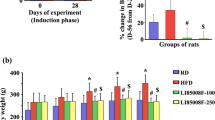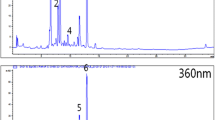Abstract
Objective
To investigate the effects of Chang-Chul-Eui-Ee-In-Tang (苍术薏苡仁汤, CCEET), modififi ed CCEET (MCCEET), and Semen Coicis (SC, a major component of CCEET) on energy and glucose homeostasis. The possible mechanism of action of CCEET was also determined.
Methods
A total of 100 Sprague Dawley female rats were randomly assigned to 5 groups, with 20 in each group. Rats in 4 groups were fed with a high fat diet supplementation (2 g/kg body weight), and water extracts of CCEET, MCCEET, SC, and cellulose (negative control), respectively. The last group was fed with a low-fat diet as a positive control. Results: CCEET and MCCEET decreased body weight and body fat (mesenteric and retroperitoneal fat) more than SC. This decrease was due to decreased energy intake and increased energy expenditure and fat oxidation. The improvement in energy homeostasis was associated with the enhancement of the hypothalamic leptin signalling pathway involving potentiating the phosphorylation of the signal transducer and activator of transcription-3, as well as attenuating the phosphorylation of 5’ adenosine monophosphate-activated protein kinase (AMPK). Both CCEET and MCCEET improved glucose tolerance without changing serum insulin levels during an oral glucose tolerance test but MCCEET had a better effect than CCEET.
Conclusions
Both CCEET and MCCEET safely exerted anti-obesity effects by enhancing energy balance in female rats with diet-induced obesity; MCCEET showed a better effect on glucose homeostasis.
Similar content being viewed by others
References
Lavie CJ, Milani RV, Ventura HO. Obesity and cardiovascular disease: risk factor, paradox, and impact of weight loss. J Am Coll Cardiol 2009;53:1925–1932.
Plum L, Belgardt BF, Brüning JC. Central insulin action in energy and glucose homeostasis. J Clin Invest 2006;116:1761–1766.
Sahu A. A hypothalamic role in energy balance with special emphasis on leptin. Endocrinology 2004;145:2613–2620.
Bjorbaek C, Kahn BB. Leptin signaling in the central nervous system and the periphery. Recent Prog Horm Res 2004;59:305–331.
Haque MS, Minokoshi Y, Hamai M, Iwai M, Horiuchi M, Shimazu T. Role of the sympathetic nervous system and insulin in enhancing glucose uptake in peripheral tissues after intrahypothalamic injection of leptin in rats. Diabetes 1999;48:1706–1712.
Kim SO, Yun SJ, Jung B, Lee EH, Hahm DH, Shim I, et al. Hypolipidemic effects of crude extract of adlay seed (Coix lachrymajobi Var. Mayuen) in obesity rat fed high fat diet: relations of TNF-alpha and leptin mRNA expressions and serum lipid levels. Life Sci 2004;75:1391–1404.
Yun SN, Moon SJ, Ko SK, Im BO, Chung SH. Wild ginseng prevents the onset of high-fat diet induced hyperglycemia and obesity in ICR mice. Arch Pharm Res 2004;27:790–796.
American Institute of Nutrition. AIN-93 purified diets for laboratory rodents: final report of the American Institute of Nutrition ad hoc writing committee on the reformulation of the AIN-76A rodent diet. J Nutr 1993;123:1939–1951.
Niwa H, Ogawa Y, Kido Y, Abe Y, Kobayashi M, Mori T, et al. The rate of lipid oxidation in septic rat models. Jpn J Surg 1989;19:439–445.
Lusk G. Analysis of the oxidat ion of mixtures of carbohydrate and fat. J Biol Chem 1924;59:41.
Labayen I, Forga L, Martinez JA. Nutrient oxidation and metabolic rate as affected by meals containing different proportions of carbohydrate and fat, in healthy young women. Eur J Nutr 1999;38:158–166.
Malik NM, Moore GBT, Smith G, Liu YL, Sanger GJ, Andrews PL. Behavioural and hypothalamic molecular effects of the anti-cancer agent cisplatin in the rat: a model of chemotherapy-related malaise? Pharmacol Biochem Behav 2006;83:9–20.
Park S, Hong SM, Ahn IS. Long-term ICV infusion of insulin, but not glucose, modulates body weight and hepatic insulin sensitivity through modifying hypothalamic insulin signaling pathway in type 2 diabetic rats. Neuroendocrinology 2009;89:387–399.
The Committee of Pharmacognosy. Pharmacognosy. Seoul: Dongmyungsa; 2006.
Leibel RL. Molecular physiology of weight regulation in mice and humans. Int J Obes (Lond) 2008;32:S98–S108.
Carvalheira JB, Torsoni MA, Ueno M, Amaral ME, Araújo EP, Velloso LA, et al. Cross-talk between the insulin and leptin signaling systems in rat hypothalamus. Obes Res 2005;13:48–57.
Minokoshi Y, Alquier T, Furukawa N, Kim YB, Lee A, Xue B, et al. AMP-kinase regulates food intake by responding to hormonal and nutrient signals in the hypothalamus. Nature 2004;428:569–574.
Bérubé-Parent S, Pelletier C, Doré J, Tremblay A. Effects of encapsulated green tea and Guarana extracts containing a mixture of epigallocatechin-3-gallate and caffeine on 24 h energy expenditure and fat oxidation in men. Br J Nutr 2005;94:432–436.
Diepvens K, Westerterp KR, Westerterp-Plantenga MS. Obesity and thermogenesis related to the consumption of caffeine, ephedrine, capsaicin, and green tea. Am J Physiol Regul Integr Comp Physiol 2007;292:R77–R85.
Richard D. Energy expenditure: a critical determinant of energy balance with key hypothalamic controls. Minerva Endocrinol 2007;32:173–183.
DeFronzo RA. Pathogenesis of type 2 diabetes mellitus. Med Clin North Am 2004;88:787–835.
Obici S, Zhang BB, Karkanias G, Rossetti L. Hypothalamic insulin signaling is required for inhibition of glucose production. Nature Med 2002;8:1376–1382.
Author information
Authors and Affiliations
Corresponding author
Additional information
Supported by the Korea Health 21 R&D Project, Ministry of Health and Welfare, Republic of Korea (HMP-08-A-0-80958)
Rights and permissions
About this article
Cite this article
Park, S., Lee, J.B. & Daily, J.W. Anti-Obesity effects of Chang-Chul-Eui-Ee-In-Tang (苍术薏苡仁汤) in female rats with diet-induced obesity. Chin. J. Integr. Med. 17, 925–932 (2011). https://doi.org/10.1007/s11655-011-0936-3
Received:
Published:
Issue Date:
DOI: https://doi.org/10.1007/s11655-011-0936-3




